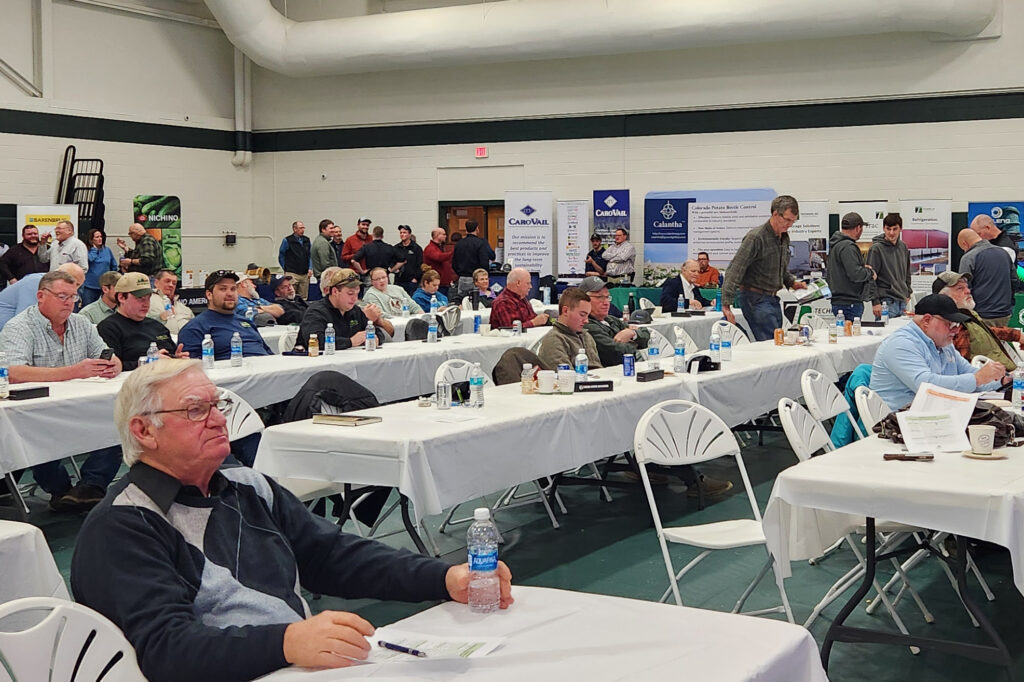
A potato industry conference in Presque Isle was the latest battleground in the ongoing war between pesticide proponents and those who say they taint the food supply.
Around 225 growers, vendors and agricultural specialists attended the annual Potato Summit on Jan. 3 and 4, held at Northern Maine Community College in Presque Isle. During the summit, Idaho researcher Jeff Miller delivered the presentation, “How much pesticide is on your plate?”
Miller’s answer: a very small amount, but not enough to harm you.
The use of pesticides in crop production has sparked debate for decades. Proponents say the Environmental Protection Agency delivers stringent testing to render the food supply safe, while those opposed to pesticide use say even a small amount of residue found on a food sample is too detrimental to people’s health to accept.
When pesticides are used according to label directions, there isn’t much left on people’s plates, said Miller, president and CEO of Miller Research in Rupert, Idaho, which works closely with that state’s potato industry. But a longtime Aroostook County organic farmer says the growing popularity of organic produce means consumers aren’t believing propaganda that says pesticides are safe. Both said the main concern is people’s health.
“There are few things that get my blood boiling like people suggesting farmers are harming the food supply,” Miller said. “I feed my family what I grow.”
The 1996 federal Food Quality Protection Act directs the secretary of agriculture to test pesticide residue on crops, especially products consumed by children.
The United States Department of Agriculture’s Agricultural Research Service has tested more than 10,000 samples per year from 2015 to 2022, according to Miller, who said 99 percent of the samples were within safe limits and no samples were above the acceptable daily intake limits.
Miller talked about “The Dirty Dozen,” a list of fruits and vegetables that contain the most pesticides. Many Americans don’t eat enough fruits and vegetables, which are known to boost health and help prevent cancer, he said. Fear-based messaging like the Dirty Dozen reduces produce consumption, he said.
The 2023 Dirty Dozen lists strawberries, spinach, and kale, collard and mustard greens as the top pesticide-containing foods. Blueberries, another key Maine crop, are 11th. Potatoes didn’t make the top 12, coming in at 16th. Data from the U.S. Food and Drug Administration and department of agriculture were used to analyze more than 46,000 samples of 46 foods, according to the Environmental Working Group.

Residue indicates the presence of pesticides but not the amount, Miller said. Many people assume if any level of pesticide is detected at all, it’s bad. But as an example, a child could eat 1,468 servings of potatoes in a day with no adverse effects, even at the highest possible residues, he said.
Testing has shown glyphosate, a common pesticide used on many foods, including potatoes, to be a safe product, Miller said.
“Gram for gram, that cup of coffee is probably more toxic for you than glyphosate,” he said.
He encouraged those at the summit to defend agricultural producers and not to be afraid to eat conventionally produced food.
Jim Gerritsen, one of the founders of longtime organic operation Wood Prairie Farm in Bridgewater, was at the conference. Everyone is entitled to an opinion, but two things came to his mind, he said Monday.
First, simply looking at residue from one chemical at a time is not enough. An apple found to have residue from two, three or more chemicals could have more effects on human health than from one chemical alone.
“The other factor I think that’s important is that, in my understanding, the data the EPA use in determining residue come from the chemical companies, who want to sell as much product as they can,” Gerritsen said.
In general, chemical companies have downplayed the dangers of their products and up-played the benefits, but they shouldn’t be providing data that the government uses in determining product safety, he said.
He, too, cited glyphosate as an example. The chemical is the major ingredient in weed killer RoundUp, which has for years been the subject of health and safety lawsuits against its original manufacturer, Monsanto, and the current owner, Bayer, Gerritsen said.
Organic food has $60 billion in sales nationwide in 2022, and in 2023 totaled $67.6 billion, according to an industry survey by the Organic Trade Association.
There’s a reason for the growth, Gerritsen said. People are more aware of where their food comes from and more concerned with their health, and the COVID-19 pandemic strengthened that trend as more people cooked at home.
Despite millions of dollars in advertising and other efforts spent by the chemical industry, consumers are slower to buy into the propaganda, he said.
“The proof is in the pudding,” Gerritsen said. “Families have figured out that there is a direct connection between the quality and health of the food they feed to their families, and what their health outcome is.”
The annual Potato Summit was hosted by the Maine Potato Board and included a trade show and numerous presentations ranging from soil health and plant performance to managing pests and disease.







